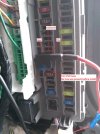VisualCSharp
New Member
I own a 2015 Honda Odyssey. I recently bought a Street Guardian SG9665GC dashcam and attempted to hardwire install it myself. All went smoothly until I reached the passenger-side fuse box, where I discovered that only the inner row of fuses were switched (see attached image).

I've read several sources that say pigtail orientation matters--in one orientation, current will pass over the tap fuse and out the tap wire, and in the other orientation it won't pass over the fuse. Knowing this, I used a multimeter and tested both prongs in an empty socket of the inside row. Unfortunately, the line prong of each socket is the outside prong (right-hand side of the left row in the attached image), which means that for current to flow over the fuse in a pigtail I would have to orient the pigtail such that the tail hits the raised part of the fuse box. I searched high and low for a different style of tap that would allow me to correctly orient the tap but found nothing. By this point, I was getting frustrated with the project so I decided to call a highly-rated Knoxville-area shop that does dashcam installs.
They did the install today, and I discovered they made at least two mistakes:
1. They installed two 15A fuses into the pigtail when the car's electrical system calls for a 7.5A fuse for socket 23. Now, there was no fuse in this socket before so it's possible that by installing a car-side fuse they created a circuit, and if that circuit draws more than 7.5A for any reason, a fire could start.
2. They installed the pigtail such that the line side of the fuse socket connects to the inside prong of the pigtail, which, from my research, means the current will pass directly over the wire un-fused.

The installer claims there "should" be a fuse in the dashcam itself. I do not know how they got that information; I have been unable to find any information about whether there is an internal fuse in the SG9665GC or its power cable. I realize the electrical components of the dashcam "should" fail under high current long before the wires catch on fire, but it's the principle of the matter: They installed a potentially un-fused circuit into the car, and also installed a fuse where there likely wasn't one before. I know I can remove their car-side fuse from the pigtail easily so I'm not making a big deal of that.
Am I in the wrong here? Is all the info I've read about fuse tap orientation incorrect? Should I take their advice that there "should" be a fuse in the dashcam so the issue is irrelevant?

I've read several sources that say pigtail orientation matters--in one orientation, current will pass over the tap fuse and out the tap wire, and in the other orientation it won't pass over the fuse. Knowing this, I used a multimeter and tested both prongs in an empty socket of the inside row. Unfortunately, the line prong of each socket is the outside prong (right-hand side of the left row in the attached image), which means that for current to flow over the fuse in a pigtail I would have to orient the pigtail such that the tail hits the raised part of the fuse box. I searched high and low for a different style of tap that would allow me to correctly orient the tap but found nothing. By this point, I was getting frustrated with the project so I decided to call a highly-rated Knoxville-area shop that does dashcam installs.
They did the install today, and I discovered they made at least two mistakes:
1. They installed two 15A fuses into the pigtail when the car's electrical system calls for a 7.5A fuse for socket 23. Now, there was no fuse in this socket before so it's possible that by installing a car-side fuse they created a circuit, and if that circuit draws more than 7.5A for any reason, a fire could start.
2. They installed the pigtail such that the line side of the fuse socket connects to the inside prong of the pigtail, which, from my research, means the current will pass directly over the wire un-fused.

The installer claims there "should" be a fuse in the dashcam itself. I do not know how they got that information; I have been unable to find any information about whether there is an internal fuse in the SG9665GC or its power cable. I realize the electrical components of the dashcam "should" fail under high current long before the wires catch on fire, but it's the principle of the matter: They installed a potentially un-fused circuit into the car, and also installed a fuse where there likely wasn't one before. I know I can remove their car-side fuse from the pigtail easily so I'm not making a big deal of that.
Am I in the wrong here? Is all the info I've read about fuse tap orientation incorrect? Should I take their advice that there "should" be a fuse in the dashcam so the issue is irrelevant?
Last edited:
